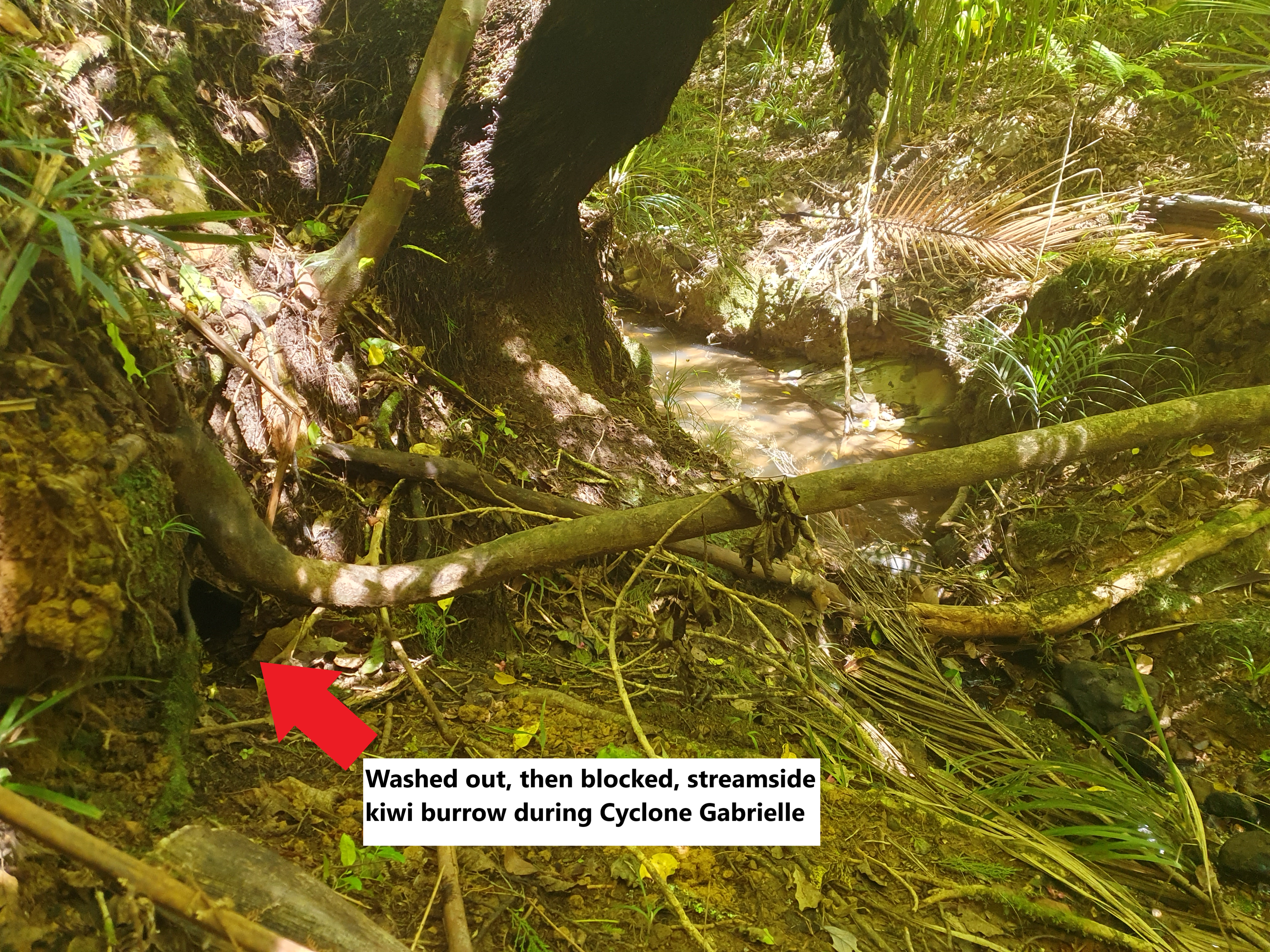In Northland we have mostly worried about droughts in terms of climate change impacts on kiwi, but the last few weeks have really reminded us climate extremes occur at both ends of the spectrum!
What did kiwi do during the cyclone? How do kiwi cope? What are their survival tactics? Answer is we really do not know all that much.

Reports from around the region suggest that during Cyclone Gabrielle kiwi employed different survival tactics based on the storm severity at their location and their burrow style.
Some clay bank burrowers lost their homes – especially on stream sides – but will easily dig new ones and usually have 3 – 4 burrows in use at any one time in their territories.
Kiwi who hunkered down in old hollow logs on ridges generally stayed put, and others seemed to have no concerns and happily went about their usual business through the rain!
What we know for sure comes from just a handful of wild Northland kiwi that have leg-fitted radio transmitters. Data from the transmitters tells us of hours out feeding, location and nesting activity. During the severe droughts of 2019 and 2020 we learned that kiwi were out feeding for 13 hours a night, instead of the usual 8 – 10, trying to get enough nourishment. This meant they were active in daylight hours over the summers and ended up in some dangerous places like roads, water troughs and swimming pools. They also migrated following the water in streams and waterways as they dried up. The drier it got, the further they went. But most returned to their usual territories once the autumn rains arrived. Fewer nests occurred as well as birds struggled to maintain bodyweight and kiwi call rates plummeted.
Thanks to the incredible effort by the 210+ groups and projects linked into Kiwi Coast, howerver, it is becoming safer and safer for kiwi to move quickly out of harms way during extreme climate events and to find food and shelter.
There are now over 240,000 hectares of land across Northland where predators are being reduced, habitats are healthier and comunities have committed to excellent dog control. Kiwi Coast strategically supports the linking of discrete pest control areas to create “kiwi corridors” or landscape-scale networks through which wildlife can move quickly and safely when needed. But how well is this working? What are sinks and barriers? How do we make it better? More transmittered kiwi are needed to generate this vital information.
The ability of Northland brown kiwi to be resilient in the face of increasing climate change impacts is somewhat hampered by their ancient life-cycle. Taking 2 – 3 months to hatch those huge eggs is tricky business. What may start out as a good nesting season, doesn’t always last.

There may be plentiful food supplies in July and August- the peak mating time of Northland kiwi, but when hatching starts in October it can already be getting hot and dry. And second clutches could do it even harder! The chicks really struggle to feed and gain weight in dry years – so it takes longer for them to reach the 1kg mark when they can start being able to fight off one of their key predators – stoats. Transmitter data also shows that most incubating Dads stayed on their nests during droughts despite losing lots of weight. When would they abandon? We do not know.
Lucky they are smart. Well, we think so. They have a big brain for their size and are one of the few ground dwelling birds to survive after all!!
This year has been a whole different ballgame. Long wet summers mean kiwi do very well. Lots of food means two, maybe three nests in a year, fat and content birds and happy chicks. Birds do not mind the wet so much and you often hear them out and about in wet weather.
Extreme wet weather, flooding and cyclones however is not so good. Habitat is damaged, submerged or slips away. Nesting birds may again stay put which can be good or bad…
If the nest in a pampas on an old slip face slides, Dad may just dutifully stay – which may be his undoing. Trees can fall blocking burrow entrances. Flooded nests generally lead to rotten eggs too, or they float out of the burrow and die. Chicks will drown in quite shallow water and, despite having a great snorkel, so do some adults. Once really wet they will chill easily. Some kiwi burrows are right on creek edges and quickly flood. In fact some burrows in lime rock we have found are entered by birds swimming into them!
Some of the weather events this summer have had torrential downpours with water levels rising rapidly. A snoozy kiwi might not wake and get out in time, or gets swept away. They are not terrific swimmers but will give it a go if needed.
What we will need over the coming years is more transmitters on kiwi throughout Northland so we can better understand where they go, how they cope and what we can do to help. Our wild Northland kiwi will need to be as resilient as possible as the effects of climate change intensify – the forecast is for an increased severity and frequency of floods, droughts and cyclones. This is just the beginning.
The rest of the country see Northland as a showcase for climate change effects on wildlife. Let us get the data to help all kiwi in NZ!


